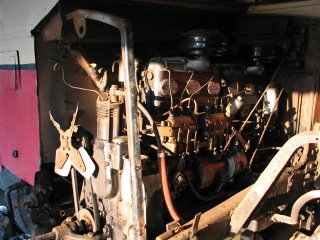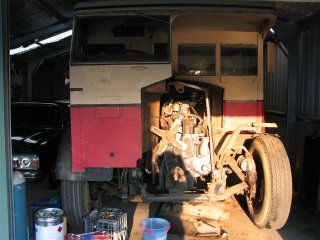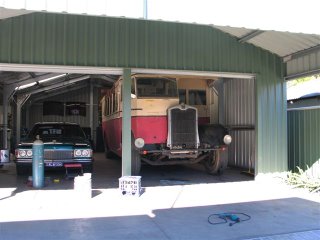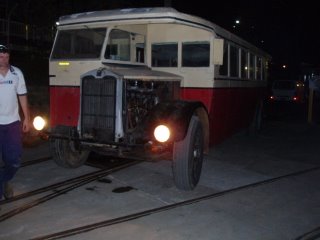The appointed day for lifting the top deck was Saturday March 25th. Craig was on a month's leave from work, father Bill is retired now, and your correspondent was eager to help.
Firstly some shunting of trams was needed. A clear space under the travelling cranes had to be created in the workshops, by moving Brisbane car 180 to another road in the Display Hall. Two wooden overhead work towers sitting on the deck of Ballast Motor 93u had to be lifted off, and 93u put in positon to receive the top deck when it came off.

David Griffiths unscrews the desto box which has brackets securing it to the floor. photo Bill Parkinson
The Gardner 6LW engine in 1615 is a little worn these days, lacking some compression, and needs a few moments cranking to get it going. Surprisingly, the electrical system is 12 volt, quite sufficient to start a Gardner, but rare by 1939 when all other diesel buses had 24 volt systems with more grunt for starting cold engines in winter.
The bus was driven down the slope to the Workshop entrance so Craig and I could get to work with angle grinders, cold chisel, crowbars and side cutters to remove the few remaining rusty bolts, and top deck lamp wiring.

Sparks fly as Craig Parkinson cuts bolts around the stair well. photo Bill Parkinson

By lunchtime, space in the workshop was now clear, and 1615 was reversed in by the west door of the shops, turned 90 degrees and positoned under the cranes. Chain drags were attached to the southern crane and hooked around the lower front corners of the top deck. At the northern end the same was done to the rear corners. These were felt to be stronger and better able to take the strain than the waist rails, which are literally a bit wasted by rust.

The method of slinging can be seen as the lift begins at dead slow speed. photo Bill Parkinson
The strain was taken, and the top deck showed a strong desire to stay attached in the region of the rear nearside destination box.. We found we had not sliced through three bolts hidden under the box where it protrudes into the top deck beside the rear three-seater. With step ladder, grinder and crowbar these were quickly dealt with and the lift recommenced.

Cutting the last remaining electrical wiring, to the front desto box. photo Bill Parkinson
This time the front destination box wanted to stay joined to the bottom deck: its winder passes through the ceiling of the drivers cab, and we had not noticed it still had the winder handle attached! After these two minor setbacks the lift proceeded and we watched closely to see if the deck would quietly form into a U-shape, suspended at each end!
In the event, not a millimetre of distortion could be detected: the skirt rails and waist rails remained dead straight. As Bill Parkinson commented, " It's just a Warren truss, really".

Aloft and completely free of the lower deck, the top deck can be seen to remain dead straight and true, a tribute to its builders. photo Bill Parkinson

The lift completed, the team waits at the other side of 93u to observe the sideways transfer of the top deck between the two driving cabs of the ballast motor. photo Bob Merchant

An aerial view from the mezzanine meal room floor shows the descent to the flat bed of the ballast motor, number 93u in the Sydney Tramways service stock register. photo Bob Merchant
The cranes travelled westwards about 5 or 6 metres and the top half of 1615 descended neatly onto the deck of 93u.
Observers immediately commented that if we placed a few chairs into the top deck space we could make 93u into a passenger car for the first time in its life.

Craig prepares packing pieces to receive the descending deck. photo Bob Merchant
Strange things happen when you take a top deck off its bus: there is no way in, no doorway to the space inside. And the floor of the top deck, a very handy place to park all sorts of things, seat frames, interior trims, glass, screws, handrails, becomes the roof of a single decker and you have to take all this junk off before you can drive it away. The photos show the before and after.

We prepare to clear the roof, until a few minutes ago a floor, of material from the stripping of the top deck interior. photo Bob Merchant

All seats, trims, glass, cushions and debris have been cleared from the roof and it has had a good sweep, preparatory to driving the bus out the door. photo Bob Merchant

The bus emerges from the west door of the workshops as a single decker. photo Bob Merchant

In Tramway Street, getting a few cobwebs out of the engine before garaging the bus back in the top shed to await driving to Craig's home in Wollongong where a lot of cutting and welding of rusted frame components will begin. photo Bob Merchant




























